Joomla SEO or Search Engine Optimization is one of the things you need to focus on if you want your website to be successful. Search traffic remains one of the highest converting channels, so investing in it is not an option but a must. However, this is not something you can do overnight and you will need to spend some time on search optimization to be effective.
However, there are some basics you can and should do to ensure that your website is at least search engine friendly. Here is a list of easy-to-implement Joomla SEO tips prepared by Qomla to ensure optimal optimization with minimum effort, which are all very important if you want to get great ranking results.
Joomla SEO tutorials and optimization tips
If you want your website to be truly Joomla SEO optimized, you need to implement as many of these SEO tips as possible. You should do this on every page of your website unless otherwise specified.
1. Choose a fast server to host your website
We'll start with something very simple. User experience is a ranking factor. The most important good user experience for a website is to have a website that is fast to access, responsive, beautiful and elegant.
Slow websites are frustrating, and most users will abandon a site that takes longer than 3 seconds to load or is overall slow.
Thus, working towards making your website fast is crucial to a good user experience and therefore the most fundamental step in Joomla SEO.
So please make sure your website, like ours www.qomla.com, is running on a good hosting server . We provide customers with free high-quality cloud servers covering website construction services, giving the website a good start in ranking.
Don't choose a shared server or a cheap hosting server. You should choose a server that is fast, reliable, and Joomla-friendly.
Remember, Google doesn’t like slow websites. In fact, Google has stated publicly many times that site speed is also a ranking factor.
2. Keyword and topic research
Any SEO content optimization starts with keyword research. Whether you’re doing SEO for a Joomla site or something else, you need to know what people are actually searching for – you can’t just assume, you need real data to prove it.
When we talk about keywords, we're not talking about the word in the traditional sense. Today, there is no need to focus strictly on specific keywords, you can and in fact should use related words of the target keyword because search engines will be better able to extract content from the article, although the actual keywords themselves are still important.
Effectively, you want to focus on both the keyword or key phrase and the search intent (i.e. what the user is really looking for when they search for this phrase). If it doesn't make a lot of sense, you don't have to be 100% accurate with the phrase, but focus on something that makes sense from the user's perspective.
Also, check what your competitors (i.e. sites ranking in the top 10-20) are doing and how they are doing it. Looking at their rankings, Google is showing you how they optimize.
Take the search ranking for "Joomla SEO" as an example. In addition to using this keyword, you can use similar keywords and phrases such as “Joomla SEO”.
You can also use Google's own tips by looking at the suggestions at the bottom of the search page or keywords in bold when searching for them.
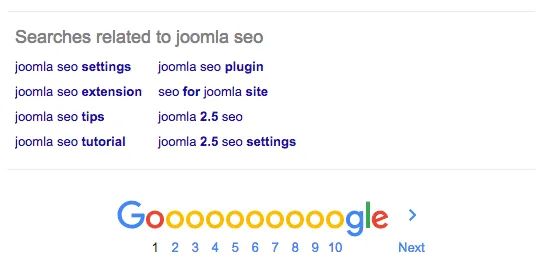
You can see below that Google boldifies SEF when searching for SEO. This means that, as far as Google is concerned, these terms are equivalent and you can use SEF in your articles.

These are the words and key phrases that Google associates with this term, so use them accordingly.
But how do you find the right keywords to target?
It's always hard to find the right keywords. They're either very, very competitive. Or they don’t have enough quality traffic. How do you find the right middle ground? Qomla can tell you how we find our good long tail keywords.
3. Enable Joomla SEF / Search Engine Friendly URL
On-page SEO has three main components:
- Browser <title> title tag
- Content <h1> tag
- URL of the page
All of these should contain your target keywords/keywords.
In this section, we will discuss the third of these components - the URL.
Joomla's default URL out of the box used to be terrible for SEO, it was a bunch of component names and parameters that only made sense from a technical perspective.
With various newer versions of Joomla, SEF URLs have gotten better and better, until today we have pretty good SEF out of the box (provided you enable them).
Although you can use the built-in support for SEF URLs, it is highly recommended that you get the dedicated Joomla SEF components - these often have significant SEO advantages over the core components.
These components can be configured with meaningful specific keywords. Generally, we recommend creating articles as:
https://www.qomla.com/about/news/seo/joomla-seo
As you can see, we don't use categories in the URL, so we can decide exactly which keywords we want to target for each specific page. Although you can choose different configurations for your site, be sure to:
- Keyword in target URL
- Keywords are used no more than once (e.g. Joomla/Joomla-templates is not ideal because it uses the keyword Joomla twice)
- Do not use extra keywords that are not part of the target keyword/phrase (e.g. 24 Easy Joomla SEO Tips Every Website Should Enable, the URL should become /joomla-seo, not 24-easy-joomla-seo -tips-every-website-should-enable)
Our favorite SEF plugin so far is sh404SEF - we have added it to the list of Joomla extensions. In addition to creating SEF URLs, it also allows you to monitor which requests are generating 404 errors so you can ensure that any broken areas of your site are repaired immediately.
These are especially useful after migrating a new website.
For most of these components (including sh404SEF), you can also choose to redirect the old URL to the new URL. sh404SEF also includes built-in support for content such as surrounding your titles via H1 tags, and other standard Google-friendly SEO techniques.
sh404SEF also supports meta descriptions and it has great support for other popular Joomla components like Kunena Forum and other popular components.

4. URL + Search Engine Optimization Organizational Structure
Google's crawler is not "intelligent." They are programmed in an attempt to make sense of the available data. They can only understand what is available based on how it is organized and the actual content itself.
Therefore, it is very important to organize the website content into a logical structure.
This means that you shouldn't put all your content into a single category (e.g. blog).
You should organize your content into categories and subcategories.
For example, in our website building feed, using categories like Joomla, Web Design, Website Building, etc., then we organize all the content into sub-categories of the main category, such as Joomla SEO, Joomla Tips, Joomla Extensions, etc.
This is organizing content into a hierarchy and grouping similar content into common categories. This helps Google and end users understand where to find specific content.
Internal linking is also crucial to creating meaningful structure. Your category should cover a list of all articles, link to all articles in that category, and the articles in that category should link to each other in a way that makes sense to users.
The good news is that the CMS Joomla SEO is perfect for this type of page. By default, it organizes all content into categories and subcategories. SEO work is about creating meaningful content within categories and subcategories. Using friendly URLs will go a long way in improving your website in the eyes of Google and other search engines.
The image below shows what your content structure should look like:
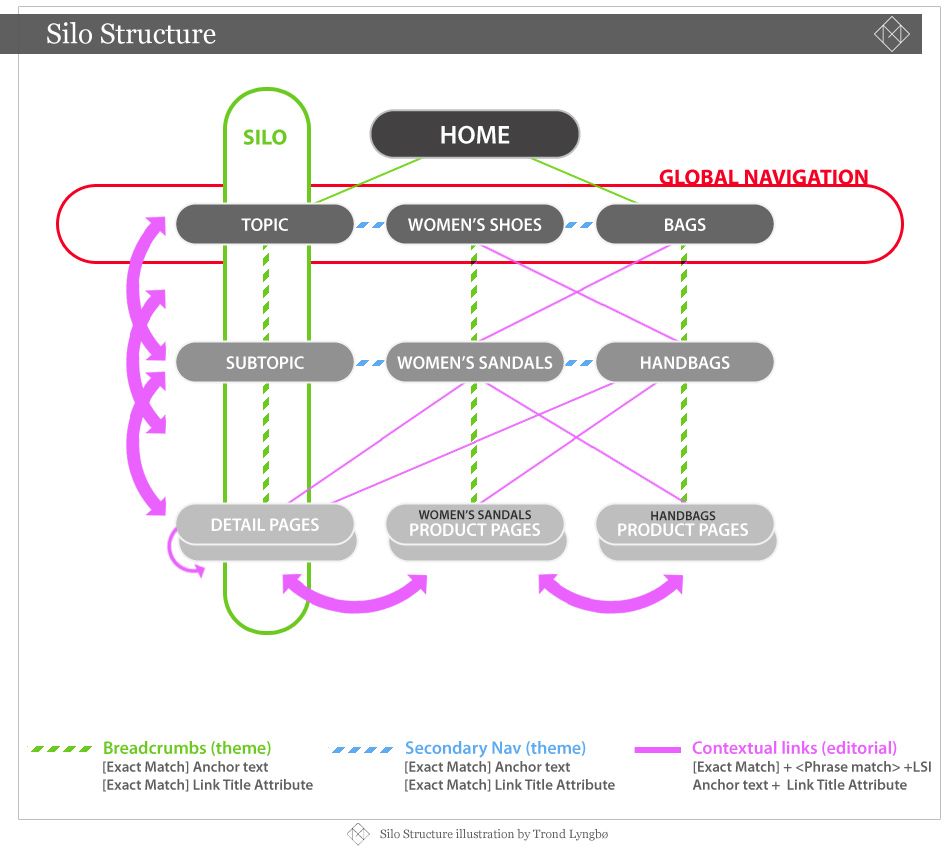
How to use Joomla categories for good SEO
Let's give an example of how to do this to optimize for a better position in search engine results pages (SERPs). We'll use the News category from Qomla's own website as an example.
Since one of the Qomla website themes is Joomla + website building, we created a category "Dynamic" and then nested multiple other specific categories below it.
So you can see there are "Announcements", "Joomla", "Website Construction", "SEO", etc. These are nested within the Joomla parent category.
We do this for all sections and categories of articles we want to talk about. Below is a screenshot of our backend.
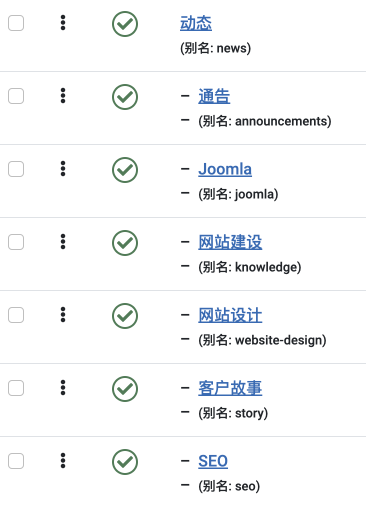
How to use Joomla menus for optimal internal linking
We have already stressed the importance of internal linking and we will mention it again in this article as it is very important for good SEO.
Internal links are great for passing on page rank (yes, page rank still exists and is used internally by Google's algorithm).
So after you create your post categories, you need to create a menu structure that is optimized for your target page (or page ranking/authority). What we did was create a homepage that linked to the Featured Articles component so that we could showcase any article from any category. Ideally, your home page should contain links to all parent categories that contain the articles you want to rank for.
Then we create a menu item linked to each parent category. For each category, we also create submenus for each nested category within the parent category.This creates an excellent top-down structure that is fully optimized for search engine crawlers.
See below how we can create our own menu structure.
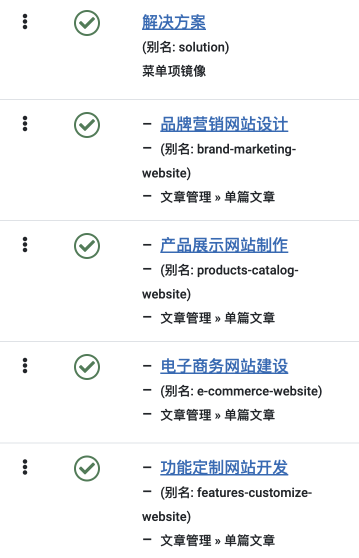
5. Avoid creating very deep link structures or very wide categories
While it makes sense to organize your content into categories and subcategories, be sure not to have too many layers. We found that categories and subcategories are more than sufficient in most cases.
Your articles should be no more than 3 clicks away from the homepage, and ideally they should be no more than 2 clicks away from the homepage. This includes pagination. You should avoid paginating articles too deeply, although this may be necessary for some sites.
Further away from 3 clicks/links, they lose too much link or page authority because the site structure is too deep.
Very broad categories may also perform poorly. If you create a parent category that is too broad, you won't be able to segment by topic. For example, Joomla components and Joomla templates are very different from each other (as far as the content of articles is concerned).
This is because ideally you want to create navigation items for categories and subcategories. Once the navigation items increase significantly, it will confuse users.
If users feel confused or lost, they will have a poor user experience. This means they will spend less time on your site and send negative ranking signals to Google.
6. Create internal links to improve page ranking
Another easy thing to do with Joomla SEO, which is often overlooked, is creating links within your website.
There are two types of internal links:
- Insert a link to this site into the article content. When you write content, you should always link to other content that you want to rank for. Such content should supplement the current topic. This reduces bounce rates and increases the time users spend on the site. Both of these send positive search engine signals and will increase rankings over time.
- Internal Structure Links – These links are used to transfer page rank from one page to another. When a page ranks well (especially if it has a lot of external links), this "link" can be passed on to other pages via internal links.
There is a lot of debate about how to set up internal linking, but these are the main two approaches. Some people prefer to manually link in-house so they have complete control over where the link flows. Others prefer to link from the menu so that the links are evenly distributed across all pages. This is especially important if all of your content is written specifically for organic traffic.
We recommend that the way you do internal structural linking is through the menu structure. We already mentioned above that you should organize your content logically by categories and subcategories.
Once you have done this, you will need to use menu links to each category and subcategory.
Take our own website as an example – a fixed menu links to all our categories and sub-categories. This means that all of our good pages pass on page rank to our other pages.
This is especially useful for ranking new content quickly - as your content will instantly get a lot of quality links.
Remember that at the very bottom of the tree you should list all the articles that you want to pass on for Page Rank.
Again, look at how it looks on our page.
Make sure there is a single URL for each page you want to rank for, i.e. the menu link.

7. Make sure you have a good XML sitemap
While we've suggested a good internal linking structure to make your site easier to crawl, a better way to show Google all of your articles and pages is to create a sitemap that Google can understand.
This can be done via an XML sitemap.
While this may sound a bit technical, it's simply a list of URLs in a format that Google understands. There are many Joomla components that can automatically generate XML sitemaps.
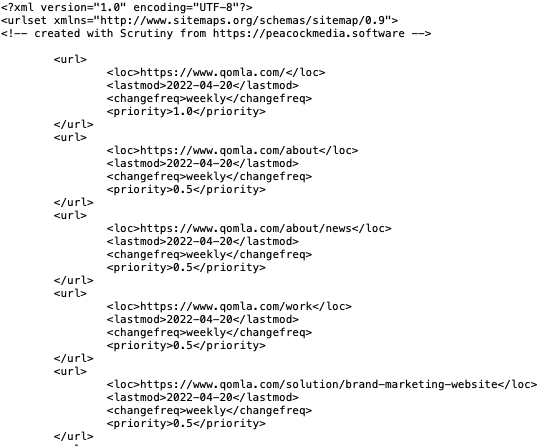
For example, you can use JSitemap, which is perfect for our purposes, but you can use others.
It is important to use a component like this so that as you add more content to your website, it is automatically added to the sitemap. It's not enough to generate a sitemap once and leave it there, it needs to be constantly updated and kept up to date as content is added.
An outdated sitemap is as good as no sitemap at all.
Google WebMasters Help also suggests and recommends reasons why you should have a sitemap.
8. Submit XML sitemap to Google Search Console
Most sitemap components will generate a sitemap under the URL /sitemap.xml, which is where search engine crawlers will look for it.
However, you can go a step further by submitting an XML sitemap to Google Search Console and Bing WebMasters to instruct search engine crawlers to access and obtain the XML Sitemap.
If you want to closely monitor your SEO performance, Google Search Console is an invaluable tool and one of the features it offers is the ability to submit a sitemap for your domain.
To do this, click the link above, verify your domain (usually by uploading a simple file to your website), access the Sitemap tab, and then you can submit the file directly by adding its location.

You should perform the same operation using Bing WebMaster Tools as follows:
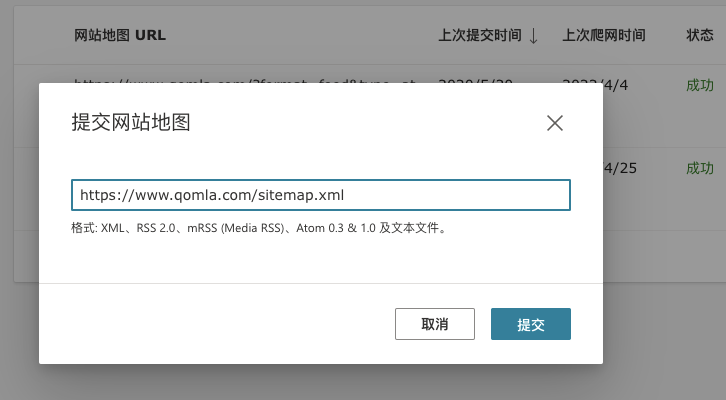
We won't go into the details of Google Search Console itself or Bing WebMaster Tools here (that's a huge topic), but if you're serious about SEO, then you'll want to make sure you visit Google Search Console regularly and understand SEO situation and then proceed to optimize your Joomla website.
These two search engines will be the ones generating the most traffic by far. Buying access to 100 million other directories is probably a waste of money.
9. Include keywords in page titles
A few paragraphs above we mentioned the three most important ranking factors you can control. The <TITLE> tag is one of the most important factors affecting page ranking.
Therefore, you need to perform a complete exercise to ensure that all pages in your site have search engine optimized <TITLE> tags. You need an attractive page title because the title is what users will see before they click through to your page:
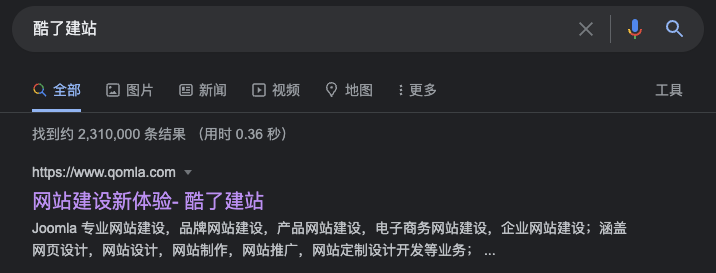
So you need to visit all your pages one by one and update the page titles, consider the following:
- Description of ranking
- The description you want to rank as close to the beginning of the title as possible (prefixed)
- It is highly attractive to users when considering their search intent
- About 60 to 65 characters long, about 30 Chinese characters (but not longer)
- Each page is unique (no two pages should have the same title)
To make it more attractive to users, you can use the following techniques
- Add a power word (improve, increase, optimize...)
- Add an (ideally odd) number if you have a list of items
- Add the year the article was last updated
- Use braces or square brackets when possible
- Use command actions (increase your traffic)
- Resolve user issues promptly (quickly, now, today)
- Highly emotional (success, failure...)
- Use title case (capitalize each word)
These are all ways to have a compelling TITLE. Having a headline like this will entice users to click so they can reap the benefits you are promoting.
In addition to the actual title itself, if your page gets more clicks from search engine ranking pages, it will start to climb in the rankings thanks to an attractive title. In fact, if you want to perform this exercise well, you should look at the pages your page competes with and make sure your title is better than your competitor's title.
10. Make your content title (H1) different from the browser title
This is an interesting thing that you don't find in many places.
The reason for this is that most CMS like Joomla and WordPress will define an H1 tag and a TITLE tag created from the post name.
This is almost accepted behavior. But research from various SEO organizations shows that having an H1 and a TITLE tag that both contain the target keyword but are slightly different from each other is better than having the H1 and Title be the same.
Just as an example, if your target keyword is "Joomla SEO components", it is recommended that you use:
Browser title: "Top 9 Best Joomla SEO Components"
Article content H1: "Want to rank #1 fast? These are the 9 best Joomla SEO components"
Can you see how we are targeting the keyword in both cases, but the actual title/h1 is different?
SettingsThe method for Joomla differs depending on whether you have the SEO component installed or not. Using sh404SEF, you can create a custom title by going to the SEF URL section and creating a custom post title.
In this course Joomla you can do this by specifying the browser page title in the article's option settings or in the menu item's options, as shown below. While you are in the article, go to the Options tab:
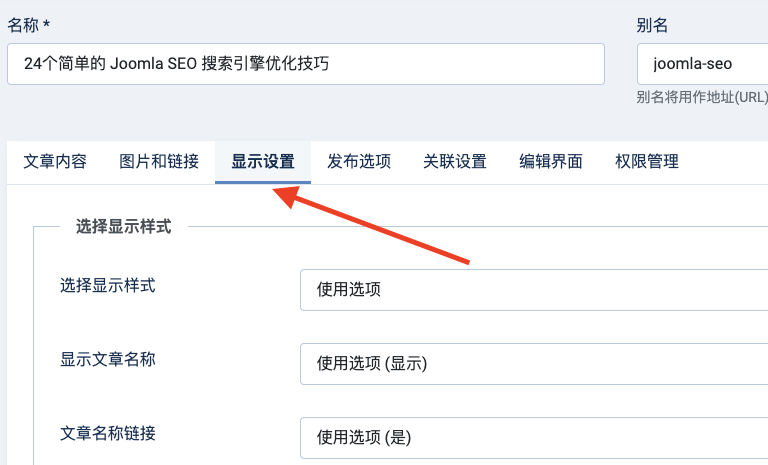
Scroll to the very bottom of the screen until you find the browser page title setting and enter a title as suggested above. Remember, your H1 will be the name of the article, and the browser page title will be the TITLE tag.
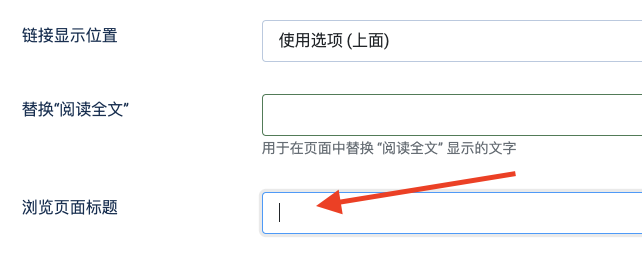
11. Include target keywords in meta description
For Joomla SEO, META description is also another relatively important factor. Search engines sometimes (not always) use meta descriptions to create descriptions or previews in search engine results pages.
The searched keywords are shown in bold in the results and we can see the exact description we used on this page. In the META, we create a snippet that describes the content of the page and tries to entice the user to click on the result.
Once again, if you carefully implement your title and meta description in a way that increases your click-through rate (the percentage of total people who click on your result), you can have a huge positive impact on your ranking results.
META descriptions also get high marks from Google. When you perform seo optimization on the TITLE tag, you should also do the same with the descriptions so that each page has a unique description.
Also, especially for Joomla SEO, remember to create a search engine optimized description for your entire Joomla website.
SEO settings can be found under System > Global Configuration > Metadata Settings > Site Meta Description. Using the same “logic” we followed above, create a meta description that carefully describes what your site is all about.

By the way, you can ignore the META keyword in your SEO settings. META keywords are ignored by search engines, so don’t bother filling them in, they have zero relevance to Google.
12. Make sure the robot is set to Index, Follow
This is important as part of your SEO setup.
In the image above, directly below the site keywords, there is a robots section.
This section specifically tells search engines whether to crawl and index your Joomla site. Make sure it is set to:
Index,Follow
These are called search engine directives, however, if you mistakenly set them to NoIndex, search engines will refuse to crawl and index your site, and your site will not appear in search engines.
There are some SEO basics that apply to any CMS, whether it’s Joomla, or WordPress, or anything else written on the web.
If you don't want the post or menu item to appear in search engines, you can go to the "Publish" tab and change the "Robots" label accordingly. If you do not want your articles to be indexed, set them to: No Index, No Follow.
13. Set up structured data
Structured data is a standard format used to present information about a page and its content in a language that search engines understand.
Rather than presenting all data as content, structured data provides a better definition of the content so that search engines can understand the context and be able to better represent the data.
In particular, structured data can better define real-world objects and events, such as:
- Products
- Activities
- Recipe
- Comments
- Article
- Publisher
- Local Business
- Creative works
- Books
- Movies
- People
- Organization
- FAQ
- How
- Wait, wait, wait
By using this structured data, search engines will be able to extract the semantics of the content on your pages and then use that information to better represent your content in search engine results pages.
This data can be used to get better placements, for example:
- Rich snippets
- Knowledge Graph
- Google News
- Comments
- FAQ
- How
This is a very neat trick and easy to implement. For the Joomla project we use the excellent Joomla Structured Data Extension which allows us to include various types of structured data structures on various pages.
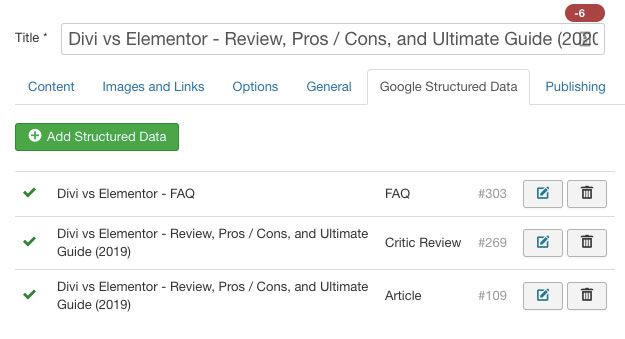
The most common things we use are:
- Articles (we use this in every article)
- Ratings (when we review a product)
- FAQ (when we create an FAQ)
- Product (when commenting on a product)
- Thanks to this feature we were able to get the following SERPs:
Getting this structured data right will make your Joomla site more search engine friendly.
14. Optimize your Robots.txt file to allow indexing of images
Here are a few ways you can use images to make your site SEO friendly, but they depend on Google actually indexing your images folder. This is the first step in optimization;
The only SEO optimization required is that you remove the Disallow on the images folder in the bot files. This makes the image directory search engine friendly.
Open your robots.txt file (in the root folder of your Joomla website) and remove the /images line so now search engines won't refuse to index your images.
This is what our robots.txt file looks like. As you can see, we have removed /images from the disallowed status and explicitly allowed indexing of specific image file extensions:
User-Agent: Googlebot
Allow: /*.js*
Allow: /*.css*
Allow: /*.png*
Allow: /*.jpg*
Allow: /*.gif*
Disallow: /administrator/
Disallow: /bin/
Disallow: /cache/
Disallow: / cli/
Disallow: /includes/
Disallow: /installation/
Disallow: /language/
Disallow: /layouts/
Disallow: /libraries/</code >
15. Use keywords in image title and alt tags
Good alt tags are crucial for Google to understand the meaning of the image.
Search engines can't understand actual images (so far, though they'll get there soon), so they need to understand images via:
- The context of the image (i.e. the content surrounding it)
- The name of the image (file name)
- alt tags for use with images
- There are many correlations between image file names and alt tags. Therefore, make sure the name of the image is specifically appropriate for the content and use alt tags appropriately. As with other on-page Joomla SEO optimization, use keywords if they are relevant in the image.
In general, make sure at least one image on the page has an alt tag that contains the keyword/keyphrase you want to target.
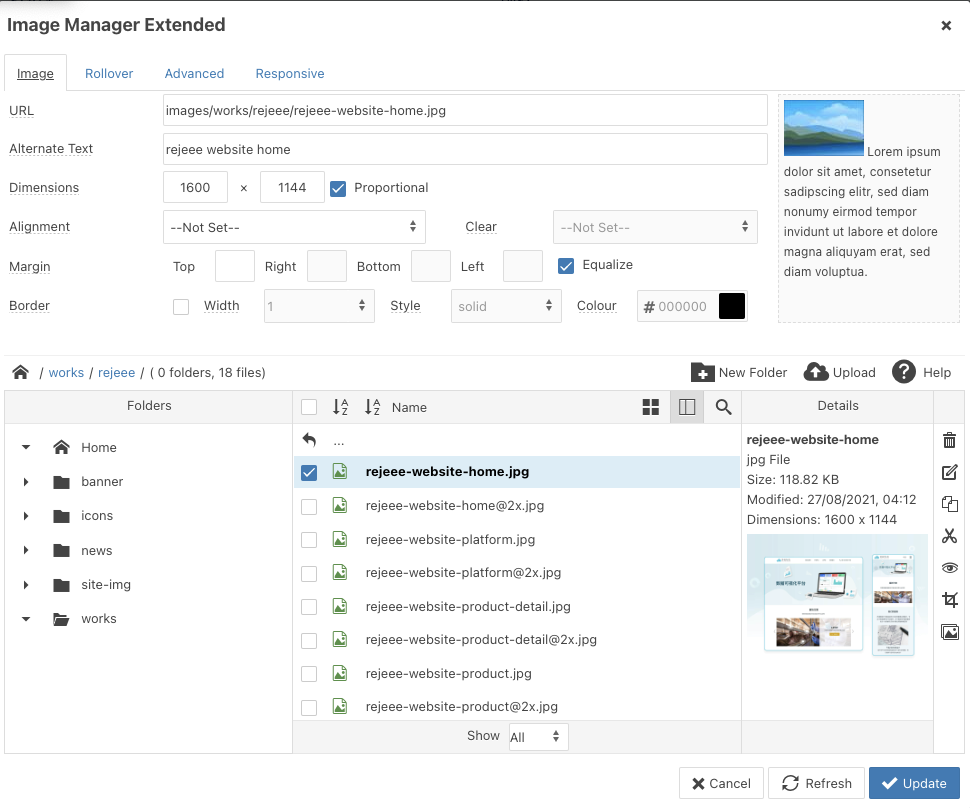
Ideally, if you want to rank for "Joomla SEO", then your first image should be called - you guessed it - the same keyword and ALT tag! The rest of the images on the page should follow a similar keyword-rich naming convention, but don’t go overboard.
Keep it natural and don’t overdo it, but use keywords if they are relevant.
16. Optimize your website for faster loading
As we mentioned at the beginning of this article, site speed is a ranking factor.
While hosting is the first step, there are many other things you should do to make your website great.
Let's review some tips for making Joomla load faster:
Enable browser and server Joomla caching
Make sure content and URL caching is enabled and that Joomla! is loading as fast as possible.
Go to Global Configuration and enable server caching in System > Cache Settings.
Enable browser caching by enabling Joomla! System plugins available by default in Joomla (Extensions > Plugin Manager > System - Cache). Make sure browser caching is set to yes and make sure the plugin is enabled.
Enable GZIP compression
Enabling GZIP compression can help improve load times by compressing website content.
Go to Global Configuration > Server and switch the Gzip compression option to "Yes"). You can also do this at the server level by accessing the Optimize Website tab in your host.
Optimize images
You should optimize image sizes to make them as small as possible and reduce load times. We use ImageRecycle, a tool that compresses image size without automatically losing image quality.
Specify image dimensions when including images
This allows space to be reserved on the site before your image actually loads. This makes your website load faster, and it’s been proven time and time again that a faster loading website helps a lot with SEO.
Enable lazy loading of images
We use a plugin to lazy load images (only display them when the user scrolls to them instead of loading them all at once). We use the simple plugin LLFJ (Lazy Loading for Joomla), which you can download at Download here.
Utilize browser caching
This command allows the browser to cache images locally for one year. This ensures that the image does not have to be downloaded over and over again.
Add the following text to the bottom of the .htaccess file:
<FilesMatch "\.(ico|pdf|flv|jpg|jpeg|png|gif|js|css|swf)$">
Header set Cache-Control "max-age =29030400, public"
</FilesMatch>
Specify default charset
Just add the following line in .htaccess to specify default charset
AddDefaultCharset UTF-8
If this doesn't work, research how to do this on your hosting server. Here's a good place to start https://www.askapache.com/htaccess/ place
Remove captions.js and mootool.js
Check if any components are using captions.js and Mootools scripts.
If not, then it's best to abandon them. These two scripts are added for some JCaption features that many times your website does not use, so you can remove these two javascript libraries completely. The mootool.js file itself is a nice 70K file, so removing it would go a long way in reducing the overall download size of the site.
You can enable/disable this functionality as needed on your Joomla site using a plugin such as this one.
17. Make sure your Joomla website is mobile-friendly
This is quite old advice at this point, but there's no harm in including it.

In April 2015, Google made strong ranking signal changes. Essentially, if a website is mobile-friendly or fully responsive, it will be favored in search engine results over websites that are not.
By default, this means that if your Joomla site is not mobile-friendly, your site will receive a strong negative ranking signal. So, if your website fails the Google mobile-friendliness test - make sure you make the necessary changes to make it responsive and mobile-friendly.
If your site is still using an old template or the old Joomla engine, we recommend upgrading both to ensure it takes advantage of a mobile-friendly theme.
18. Create a blog and start blogging
Blogging or content marketing is the concept of using blogs or content to create content that focuses on driving search engine traffic, social traffic, and generally using the content to act as a traffic magnet.
As this site has explained many times, quality content flowing across your website is crucial to modern SEO practices.
While we once recommended a release schedule, we no longer do so. Just make sure the content you post is useful to your target audience. Forget about publishing 200-word posts just for the sake of it, if you want to be successful at content marketing, every one of your posts should aim to be the absolute best content on the internet.
If you don't write content with this in mind, you're probably wasting your time.
Find interesting and searched topics to write about. These can come from common customer and prospect questions, or you can utilize Google Autocomplete or other keyword research tools to research various blog topics.
18. Optimize your contact information/about us page
Google favors "real" businesses when ranking content. There are many websites out there that are just for making easy money from affiliates or ads.
Google often ranks actual brick-and-mortar businesses.
So make sure you are sending the right signals to Google that you are a real/legitimate business.
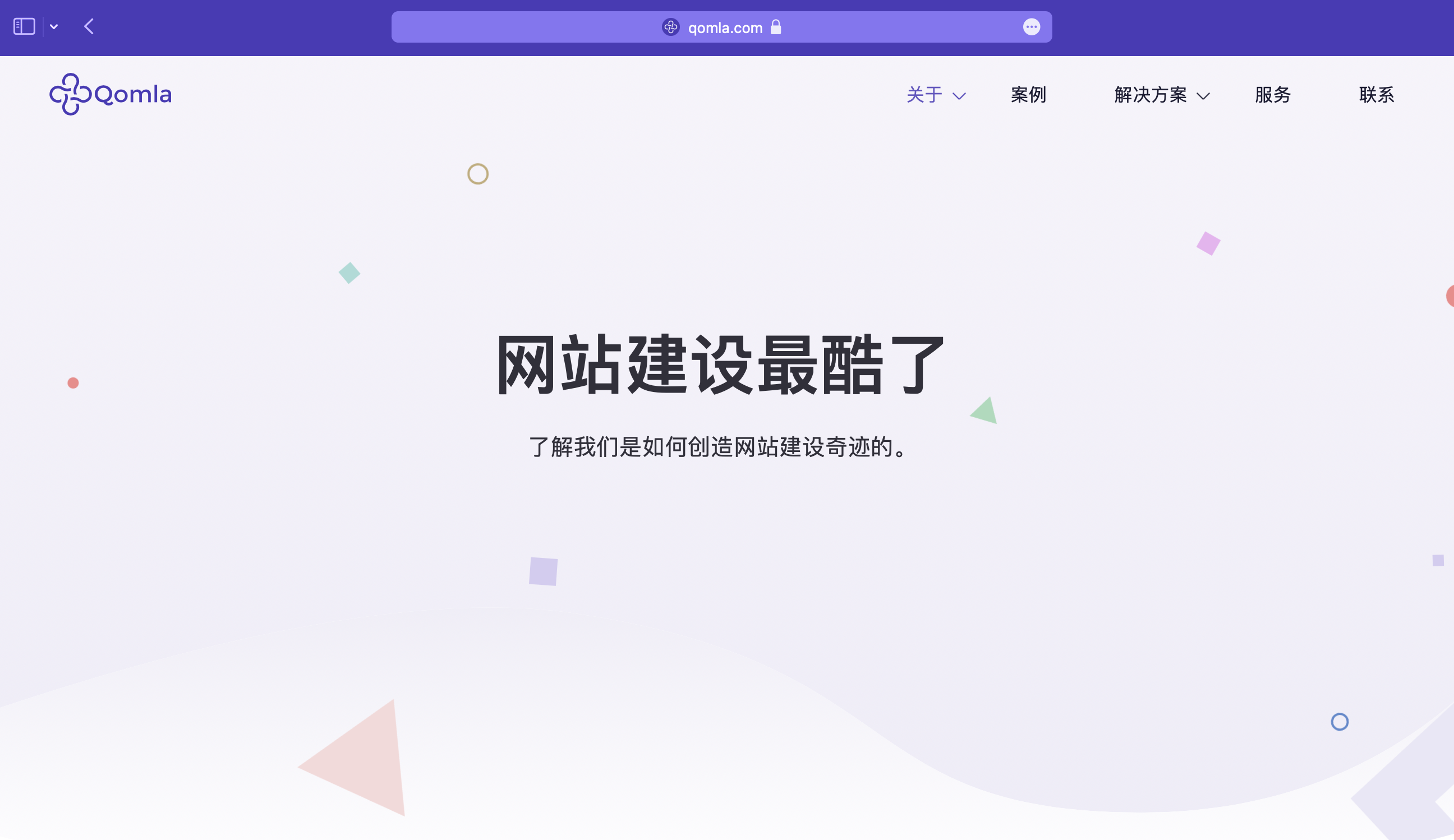
This can be accomplished through a series of strategic content.
Your contact page should contain some very key information to help connect your business to your physical location and possibly connect your business to other business listings you have on the web.
In your content pages, be sure to include your business name, address, and phone number (called a NAP).
Then link your NAP to your local Google My Business and use microdata to help improve readability. We also recommend including an embedded Google Map on your contact page to help link your business locally.
Your About Us page should also be as comprehensive as possible. Talk about your website/business team, founders, management team, your ethos, what you do, and as much information as possible.
Listing team members and including links to their social pages will go a long way in proving that your website is a real business. If you can get legitimate positive reviews on Google My Business, even better.
19. Expand your product/service offerings
If you plan to rank your product and services pages (especially local pages), make sure you have plenty of content about the services and products you offer, each on a separate page.
It's important to create completely separate pages for each service, product, or local business your business offers, rather than simply putting them on one page. In as much detail as possible, explain how your business differs from other companies and competitors.
This will allow search engines to crawl more content pages and better understand what your business is specific to.
If you are operating in multiple regions, make sure to diversify your content as much as possible, especially if using multiple localizations (i.e. don't just copy and paste content and specify different locations).
Write specific content that is unique and engaging for each individual page.
20. Optimize your footer
Just like your contact page, including your NAP and linking it to your Google My Business local account and including microdata is a very rich way to give Google a very rich understanding of your business and the relationships with you. A great way to create various business related pages.
21. Add privacy policy and terms of service pages
Similarly, privacy and other policies and terms of service pages are often provided by legitimate businesses. These give your site greater legitimacy in the eyes of search engines than a site that doesn't include these pages.
22. Find (and remove) duplicate content
Duplicate content can be a huge optimization killer. This is where the same content is displayed through different website URLs or pages.
The problem with this type of content is that Google can't easily determine which piece of content is the right one to index and rank.
This may cause your entire page's ranking to drop or bounce. You can view duplicate content in Google Webmaster Tools, or use a third-party tool like ahrefs to help review and manage duplicate content. Most of the duplicate content that occurs in Joomla (due to categories, tags, etc.) can be cleaned up using SH404SEF and/or .htaccess rewrites.
23. Work hard to build legitimate links
There is no real SEO without getting good incoming links from websites in the same industry as yours. You can do as much on-page optimization as you want, but there is no better best ranking signal than getting good links pointing to your website.
You must develop a strategy to get incoming links to your website for optimal ranking and good search engine results. The ideal way to build links is to build relationships with other website owners and get good incoming links to your best content.
Last but not least - make sure you are developing a website and content that your users will find useful and want to visit and share. There is nothing better than content for SEO optimization of your website.
Concerned Joomla issues
Is Joomla good for SEO?
Yes, Joomla is good for SEO. While it may require a few tweaks here and there, there’s no reason why Joomla isn’t great for SEO. This website has been running on Joomla for over 10 years and we have maintained excellent rankings over the years. If you perform normal on-page optimization, Joomla is as good as any other CMS such as WordPress for SEO.
How do I add keywords to my Joomla site?
To add keywords to your Joomla website, you need to do a lot. First, your content should contain the target keywords and keywords you want to rank for. You need to write content around these keywords to satisfy the needs of users searching for these keywords by providing content, services, or products that meet these needs. You should then make sure that the URL of the page contains these keywords (this usually corresponds to the alias of the article in Joomla). Also, make sure the title of the article contains your target keywords. Finally, there is a Browser Page Title setting in Joomla that can be used to specify keywords in the browser title.
How do I optimize my Joomla website?
Optimizing your Joomla site for SEO requires making some adjustments to make your site better over time. It’s a complex topic, but we’ve covered everything you need to do to optimize your Joomla website in this article.
Conclusion
Joomla SEO requires a strategy based on short-term on-page optimization, and a long-term strategy of writing great content based on keyword research and getting links to such content. If you want a solid Joomla SEO strategy, just follow these steps.
There are a lot of things you can do to get great Joomla SEO optimization - but these are a great place to start!